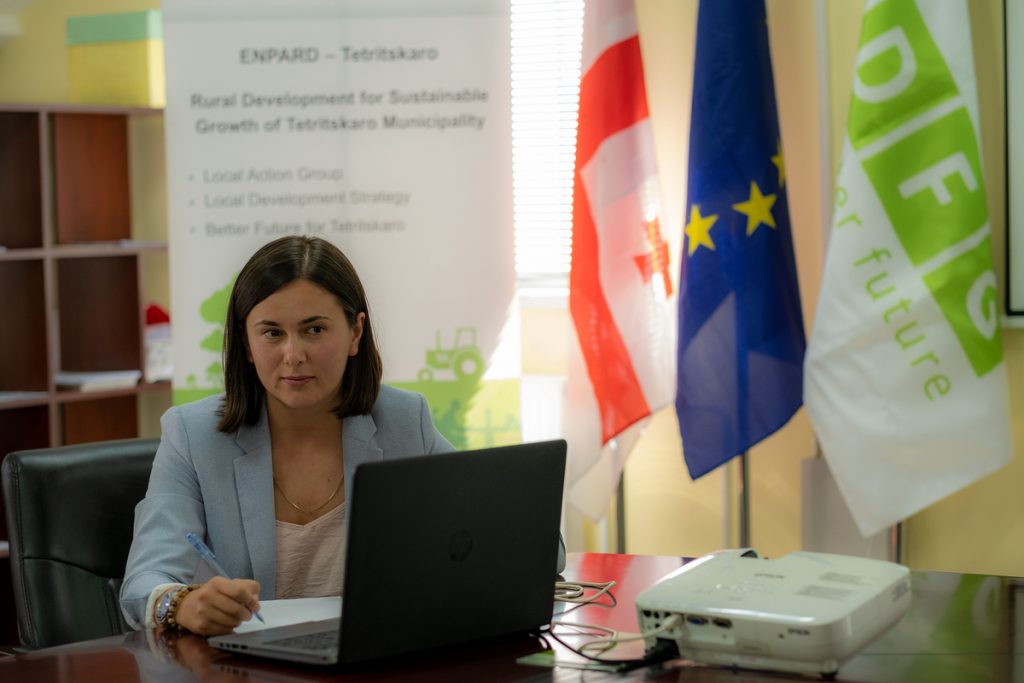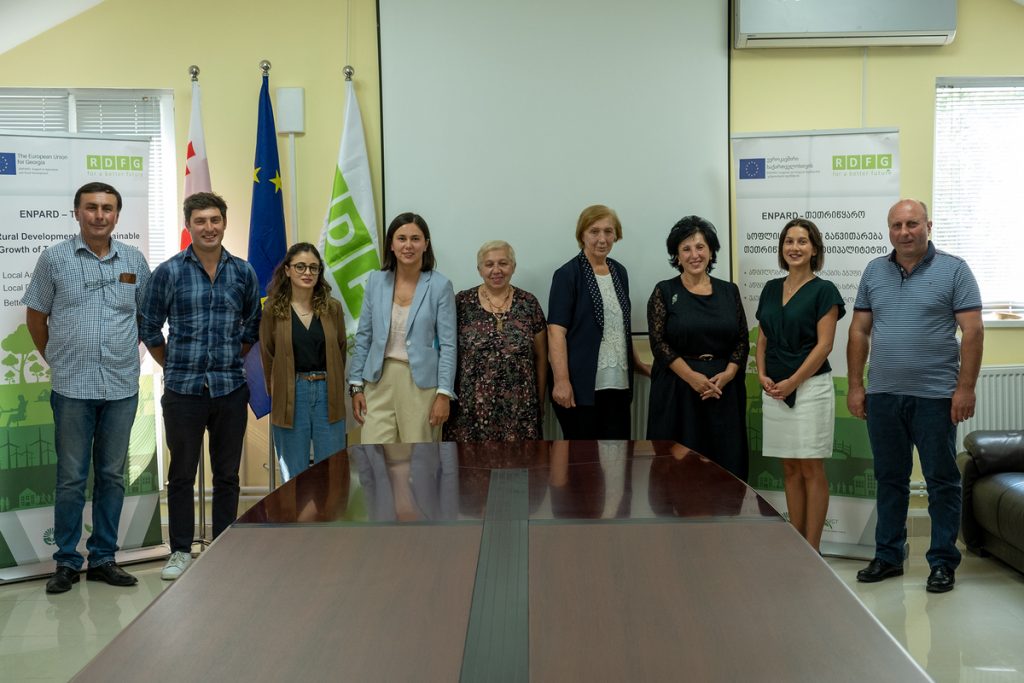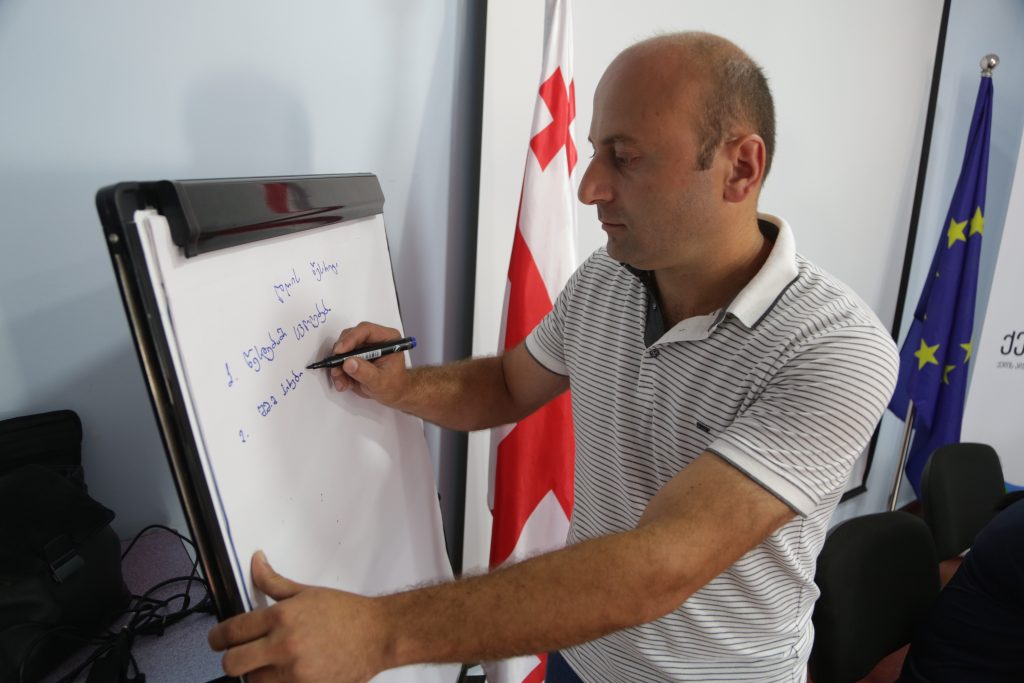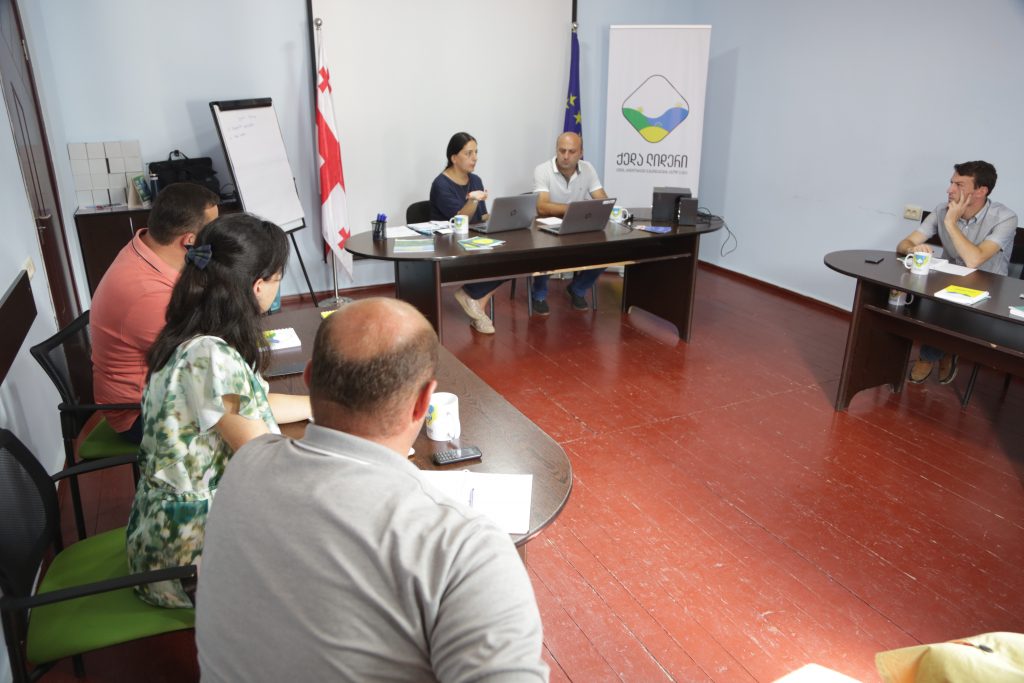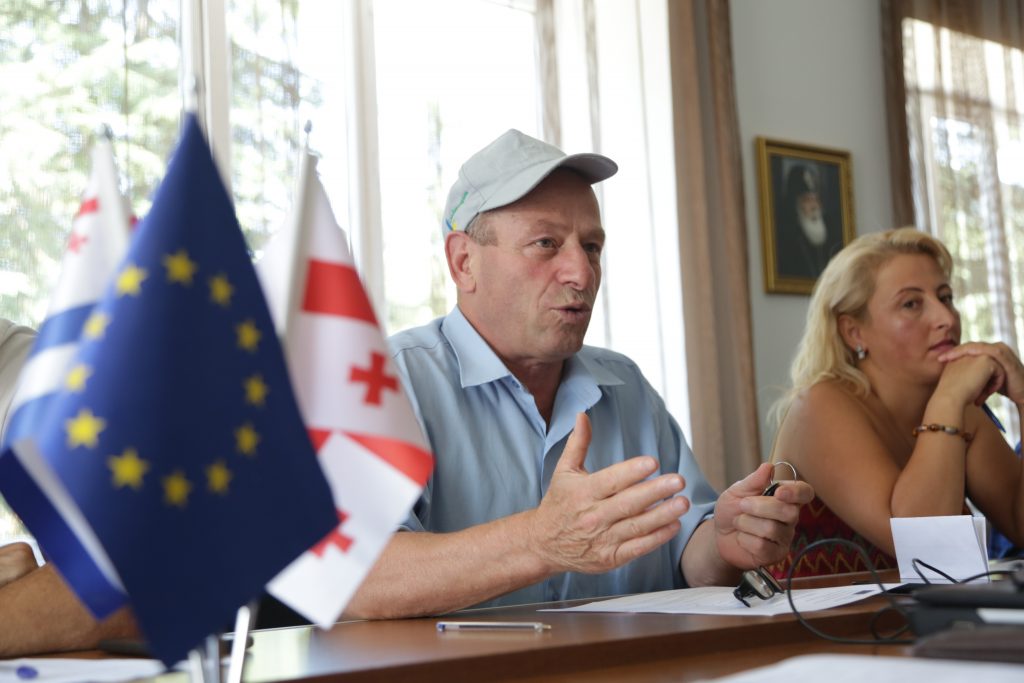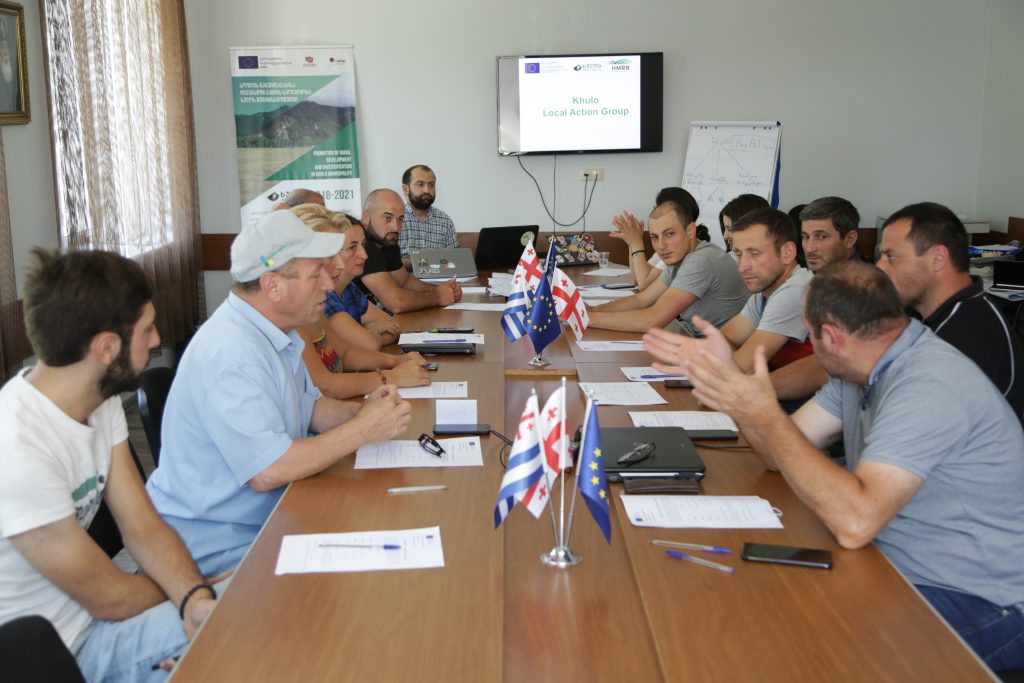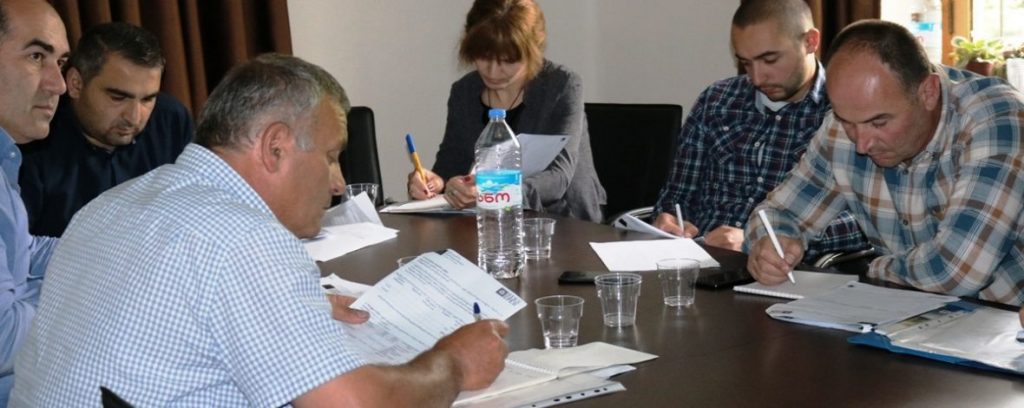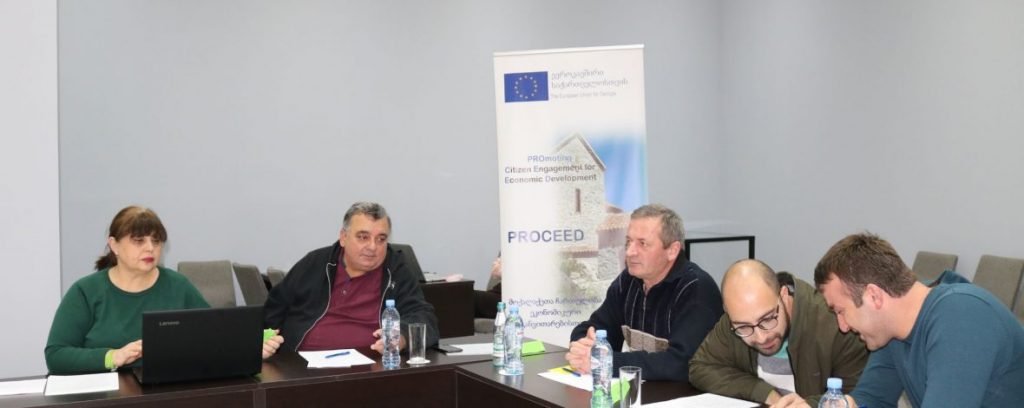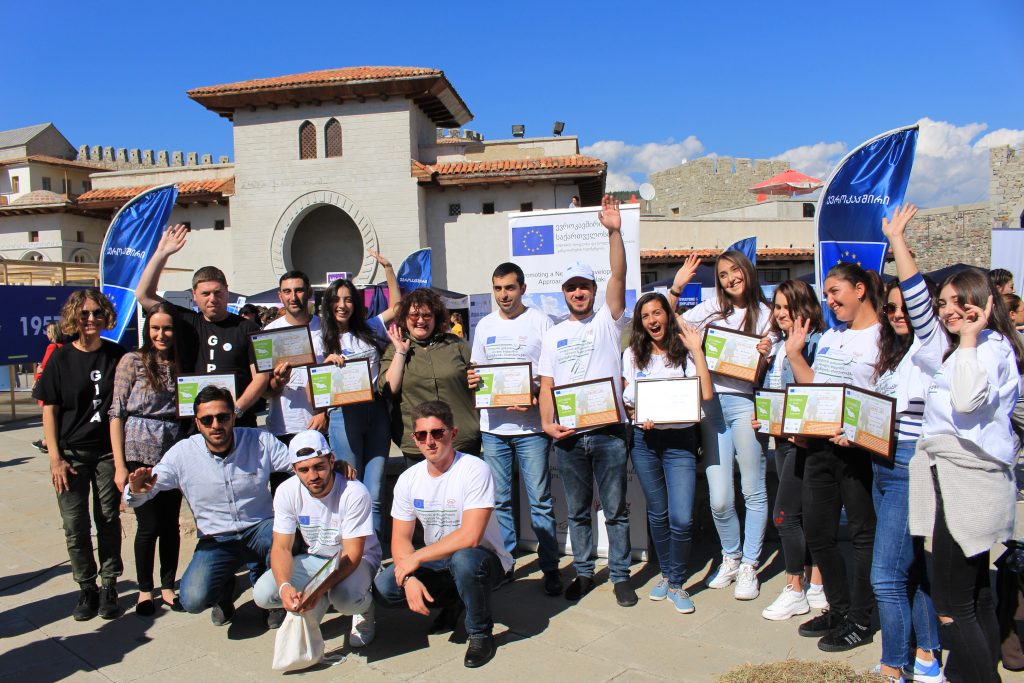
Local Action Groups Empower Communities in Georgia
EU-supported Local Action Groups (LAGs) in Georgia follow with democratic principles of governance and development, and envisage active public involvement and participation in decision-making. LAGs bring together private, public and civil society sectors at the local level. They identify rural development priorities and draft local development strategies based on the municipality’s needs and capabilities analysis, and then provide EU-funded grants to support local development initiatives. Here we would like to bring you success stories of some of the Georgian LAGs.
Tetritskaro LAG
The Tetritskaro LAG has been functioning for three years and over the time, has managed to dispel the community’s skepticism and engage the local civil, public and private sectors in everyday activities. By identifying and addressing needs and challenges, the LAG has completely changed the municipality’s life: locals have realized they could make their wishes or dreams a reality in their neighborhood.
In its activities, the Tetritskaro LAG follows a consistent pattern: initiatives start with identifying a problem that is then addressed by engaging all the three sectors. Tourism, agricultural and non-agricultural sectors were known to need assistance and enhancement most of all: there were no tourist attractions, and farmers could not afford to buy necessary agricultural equipment to boost yields and productivity. With the support of the EU ENPARD programme, the LAG created new opportunities in Tetritskaro, involving the population in problem solving. Last year, more than 500 hectares of land were cultivated in the municipality, and investments were made to improve the existing and construct new family hotels/guesthouses. In addition, the Tetritskaro LAG was actively involved at the national or international level, which helped raising awareness locally.
According to Nino Tikurishvili, Chair of the Tetritskaro LAG, their activities are based on the European LEADER approach, which implies active community involvement in the development process: “Local communities know their needs better, so they identify the existing problems and decide on the ways to address them. It should be emphasized that the LAG is a multi-sectoral platform bringing together representatives of the civil, public and private sectors. It is unique and effective as it brings all the three sectors to the table so that they would share their experiences and opinions with the team for reaching a common goal.”
The Tetritskaro LAG has already funded more than 80 local development initiatives, thus completely changing the economic and social environment of the region. “It is difficult to single out a specific project, but promoting kindergartens was one of the key missions. In the first phase of the grant program, we funded the kindergarten project to arrange European standard-compliant playgrounds on the territory of nine kindergartens. In the third phase, we are going to upgrade and update their interior design, equipment and furniture, which would significantly improve the conditions of state-owned kindergartens throughout the region”, said Nino Tikurishvili.
Keda LAG
Combination of the Keda LAG and the European LEADER approach has resulted in diversification of economic activities in the region, development of local businesses, and creation of new jobs. A local development strategy has been drafted for the municipality to identify priority areas and resources and highlight strategically important areas for interference.
Keda is rich in natural and human resources that were not used properly. The municipality had no unified strategic vision for its economic development; businesses were mainly limited to agriculture and tourism, the service sector was substandard; awareness was quite low, primarily because of the lack of community organizations and inter-agency cooperation in the region.
The Local Action Group has applied the LEADER approach to project funding, mobilized local communities to participate in the municipality’s development. That opened new opportunities in the region, contributing to the development of the local economic potential, forming a strategic vision and enhancing inter-agency cooperation, as the LAG includes representatives of both public and private sectors. The Keda LAG applies a participatory approach not only helping activate the communities, but also uniting them under one goal.
The Keda LAG has funded more than 90 local initiatives that have contributed to the development of various sectors. According to Giorgi Abuladze, Chair of the Keda LAG, one of the key projects includes production of concrete poles and arrangement of vineyards, and is initiated by Avtandil Tsintsadze.
Vineyards are cultivated on 180 hectares in the Keda municipality and winemaking is also growing. The demand for wines from Upper Adjara is increasing at the market. Farmers cultivating vineyards use a lot of wood for arranging vineyard poles. Avtandil Tsintsadze replaced the practice of using wood poles with concrete ones that are more durable and reduce the need for tree-cutting. Avtandil Tsintsadze is the unique provider of such services in the region. The project helped start production of both vineyard and fence poles and offer vineyard cultivation / renovation services.
Representatives from all the three sectors in the Keda LAG continue to identify local needs and find ways to address them, believing that municipality development is based primarily on eager and active local communities.
Khulo LAG
Khulo LAG has significantly changed the situation in the municipality. There were no active civil society organizations to facilitate local civic activism. Now the LAG is planning development-oriented activities for at the overall development of the municipality.
According to Aslan Tunadze, member of the Khulo LAG, the Local Action Group has set a pattern of a civic organization in the municipality that did not exist before: “The LAG offers a way to solve many problems in terms of finding additional grants as well as arranging for discussions and advocacy campaigns. Mobilization campaigns have become much easier now – we have representatives from almost every cimmunity, which facilitates information-sharing.”
Small groups of stakeholders have been set up within the Khulo LAG, for example, a network of family hotel owners who work together and share experiences. A youth team is currently being set up at the LAG, which would implement various activities.
The LAG has encouraged greater community involvement in the municipality. Madona Bolkvadze, member of the LAG Board, says: “After joining the LAG, I became more active and interested in various community issues. Within the LAG, I try to be as active as possible and help the population with solving problems, even by giving advice or taking their issues to necessary people.”
LAG activities involve more than 30 active citizens from the Khulo Municipality, both civil and private, as well as the public sector. According to Rodam Shavadze, Chair of the Khulo LAG, Local Action Groups should involve people from different backgrounds, experiences, and ages in order to diversify LAG’s activities: “This would let us be more objective and attract more people. Involvement of young people is especially important, because our future depends on them, so what empowers youth is well-spent.”
The Khulo LAG has funded 73 local development initiatives that help the municipality in a number of ways. At this point we can single out some business projects that have significantly changed the situation in the municipality. The LAG has funded two sewing shop projects in the communities of Khulo and Gorjomi. Both sewing shops employ up to 15 women who say that is their first job and who feel very happy working there.
The LAG also funded Besik Dekanadze’s project to fully equip a dental workshop: “It will help me serve dental clinics of highland Adjara at lower prices, and to reduce the costs for the population. On average, I produce dental products at a price 15-20% lower than in Batumi, which makes me more competitive and offers significant benefits for the population.”
Dedoplistskaro LAG
In the three years of its functioning, the Dedoplistskaro LAG has funded 111 initiatives and created hundreds of jobs. The implemented projects offer jobs to local construction companies, suppliers, and drivers, and up to 500 applicants have been trained in project-writing and business plan-drafting.
According to Dedoplistskaro LAG Chair Ana Benashvili, members of the LAG Board have also gained a lot of experience during this period: “We have received serious and diverse trainings, and visited our partners in Romania and Spain to get acquainted with the work of European LAGs, where we had interesting meetings and got to know their methodology and their funded projects that contribute to regional development. The EU-supported ENPARD initiative assists the country in fulfilling its obligations under the EU-Georgia Association Agreement, implementing national plans at the local level, identifying specific needs and addressing existing challenges. LAGs act as a tool to implement these goals at the level of a region, municipality or community. That’s the mission of LAGs – to move towards European democracy and development through cross-sectoral cooperation and introduction of the LEADER methodology.”
The Dedoplistskaro LAG has representatives from almost all villages, and the three-year activities have revived the villagers who developed the ambition to write projects, get repeated funding and enhance or start up a business: “LAG’s Board Members consult potential applicants and help them to write projects. We also collaborate with other LAGs, make study visits to each other, share experiences and success stories, and plan for future collaboration,” says Anna.
The LAG supports both private sector/business development and the improvement of social services. It has assisted to expand local hotel networks, training and information centers, and sports and health facilities. During the Covid-19 pandemic, the Utility Services Center as well as health providers and rescue services received new equipment and off-road vehicles. Kindergartens were provided with various dispensers for sanitation. Local population received funding to buy necessary equipment for construction and agricultural activities, re-equip their wine cellars, laboratories, small enterprises for alcohol and fruit processing, and different workshops.
“For example, Nasrashvili Cellar participates in international exhibitions and already has export offers. Ketevan Chalakheshashvili’s cheese enterprise already offers its cheese in the Fresco supermarket chain, Jaba Gigolashvili’s asparagus-growing farm from village Ozaani sells its product in AgroHub supermarkets. The owner of a newly built 86-hectare walnut plantation in Samtatskaro received funding to buy irrigation pumps.
Gradually, step by step, products of LAG’s beneficiaries started appearing at the local market, including dried fruit from “Charozi”, nuts, dairy, mushrooms from greenhouses, different vegetables, and decorative flowers; poultry including chicken, pheasant and partridge; cloisonné enamel, silver jewelry, ironware and glassware, and bed linen. Georgian rugs, felt and leather handbags made in the “Roots” workshop are sold abroad (on order). We hope in future these enterprises become stronger and develop in other directions as well,’ says Anna.
Akhalkalaki LAG
Like many other municipalities in Georgia, Akhalkalaki’s major problems are unemployment or lack of jobs, urbanization, and the outflow of young people. However, there are also challenges you would rarely encounter in other municipalities.
The majority of the population there are ethnic Armenians (93.8%), 5.7% are ethnic Georgians, and 0.5% belong to other ethnic groups: Russians, Greeks, etc. These groups have problems with the knowledge of the Georgian language, and though the situation is improving, there are still problems of social integration and education – the lack of the language skills is obviously a barrier to communication. Therefore, Georgian classes are necessary to promote social integration of the ethnic minorities, and the Akhalkalaki LAG is actively involved in the language initiative.
Apart from important economic, social and cultural-educational projects, for over a year the LAG’s Resource Center has been offering free Georgian and English language classes as well as training in record-keeping and financial accounting, painting, and others.
The LAG’s effective work depends on its members: on the mobilization of the local private, public and civil sectors to identify and respond to problems in the region. Based on the analysis of the municipality’s needs and capabilities, the LAG identifies development priorities and drafts a local development strategy.
To date, the Akhalkalaki LAG has supported over 40 local initiatives of different kinds. The LAG Resource Center also used the COVID-19 pandemic period to develop further: it launched online training courses of the Georgian language for the local ethnic Armenians. The first online session was conducted on the Georgian Language Day, April 14. The initiative covered 30 people for whom the project means a lot, as it directly addresses the problem many of them face in their everyday life.
“State language mastery is a key precondition for the young generation to socially integrate in their home country. If you do not speak your state language, you find it difficult to adapt. The LAG helps young people address this problem, thus facilitating their life and communication in the country,” says Teresa Chivchiani, a member of the Akhalkalaki LAG and Director of the Resource Center.
According to the Akhalkalaki LAG, they plan to introduce many innovations in the future, and want to eliminate problems in the community as soon as possible thus making life easier for the locals.
***
With EU’s support, Local Action Groups have already been established in 12 Georgian municipalities, including Lagodekhi, Borjomi, Kazbegi, Tetritskaro, Akhalkalaki, Dedoplistskaro, Keda, Khulo, Tsalka, Akhmeta, Tskaltubo and Mestia. To date, the EU-supported LAGs have funded over 500 rural development initiatives in the fields of agriculture, tourism, social and rural infrastructure development, and environment, providing new employment and income-generating opportunities to more than 1,000 rural households and improving livelihoods of over 10,000 rural residents. Yet, local development groups go far beyond numbers – they bring together the vision, energy and commitment of rural people.
